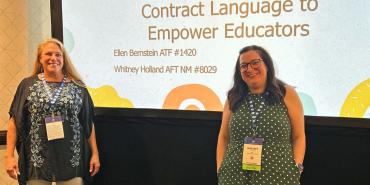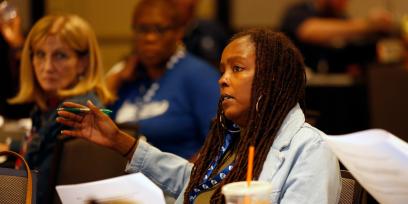What can unions do to ensure that their good work lasts throughout time? That’s the question posed and answered during the Friday morning workshop “Freedom to Teach: Leveraging Partnerships and Contract Language to Empower Educators” at the AFT TEACH conference.
In a session that blended strategy with storytelling, Ellen Bernstein, president of the Albuquerque Teachers Federation, and Whitney Holland, president of AFT New Mexico, shared how the ATF was able to partner with school administrators to maintain autonomy for educators through collective bargaining in the face of conflict with the superintendent and newly elected board members.
Through strategic collective bargaining, the union secured contract language that protected teacher autonomy and professional judgment, even during turbulent transitions. “We get new superintendents, we get new board members, and we get all kinds of different things legislated to us,” said Bernstein, noting that the contract language follows through those transitions. “My theory of action as a local president is, if you don't have it in the contract, then it's going to disappear every time the superintendent or the board suddenly decides this is not a good thing to do.”
Workshop participants strongly agreed: Educator autonomy—the right of teachers to make informed, professional decisions in the classroom—is essential. As professionals, teachers deserve to be treated as such.
Bernstein recalled a defining moment in her early leadership: “I was so fortunate when I started as union president,” she said, to have an active, organized union ready to take on challenges. The superintendent wanted to end binding arbitration, have teachers work longer for the same amount of money, and take away site-based decision-making that the union had negotiated.
The union fought back. Thousands of teachers showed up at board meetings. They leveraged pressure strategically—using the superintendent to push back against the board when needed and vice versa. “We’re always making sure we can leverage power,” Bernstein explained.
To prevent future conflicts, the union and the board president agreed to contract language that included a shared commitment to collaboration in the best interests of students. It was embedded in the negotiating agreement—a “living contract” designed to outlast leadership changes
The strategy was put to the test recently, when the composition of the school board changed. Almost immediately after the election, attacks on the collective bargaining agreement began—and the professional autonomy language was the focus of the attack by the board’s more conservative members.
But the union was ready. It mobilized—rallying community allies, launching social media campaigns, and recruiting pro-education board candidates committed to inclusive, student-centered curricula.
The key takeaway? Persistent, strategic organizing that builds community support and keeps educators at the heart of decision-making.
“I never ever thought I was going to have one of those awful school boards,” Bernstein admitted. But when it happened, she was grateful the union had already done the hard work to create a contract that was enforceable and protected members when they needed it the most.
[Adrienne Coles]


